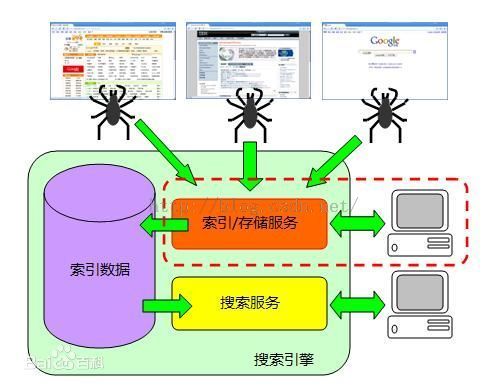三.分组查询:
1. Field Facet
Facet 字段通过在请求中加入 ”facet.field” 参数加以声明 , 如果需要对多个字段进行 Facet查询 , 那么将该参数声明多次 . 比如
|
/select?q=联想 &facet=on &facet.field=cpu &facet.field=videoCard |
各个 Facet 字段互不影响 , 且可以针对每个 Facet 字段设置查询参数 . 以下介绍的参数既可以应用于所有的 Facet 字段 , 也可以应用于每个单独的 Facet 字段 . 应用于单独的字段时通过
|
f.字段名.参数名=参数值 |
这种方式调用 . 比如 facet.prefix 参数应用于 cpu 字段 , 可以采用如下形式
|
f.cpu.facet.prefix=Intel |
1.1 facet.prefix
表示 Facet 字段值的前缀 . 比如 ”facet.field=cpu&facet.prefix=Intel”, 那么对 cpu字段进行 Facet 查询 , 返回的 cpu 都是以 ”Intel” 开头的 ,”AMD” 开头的 cpu 型号将不会被统计在内 .
1.2 facet.sort
表示 Facet 字段值以哪种顺序返回 . 可接受的值为 true(count)|false(index,lex). true(count) 表示按照 count 值从大到小排列 . false(index,lex) 表示按照字段值的自然顺序 (字母 , 数字的顺序 ) 排列 . 默认情况下为 true(count). 当 facet.limit 值为负数时 ,默认 facet.sort= false(index,lex).
1.3 facet.limit
限制 Facet 字段返回的结果条数 . 默认值为 100. 如果此值为负数 , 表示不限制 .
1.4 facet.offset
返回结果集的偏移量 , 默认为 0. 它与 facet.limit 配合使用可以达到分页的效果 .
1.5 facet.mincount
限制了 Facet 字段值的最小 count, 默认为 0. 合理设置该参数可以将用户的关注点集中在少数比较热门的领域 .
1.6 facet.missing
默认为 ””, 如果设置为 true 或者 on, 那么将统计那些该 Facet 字段值为 null 的记录.
1.7 facet.method
取值为 enum 或 fc, 默认为 fc. 该字段表示了两种 Facet 的算法 , 与执行效率相关 .
enum 适用于字段值比较少的情况 , 比如字段类型为布尔型 , 或者字段表示中国的所有省份.Solr 会遍历该字段的所有取值 , 并从 filterCache 里为每个值分配一个 filter( 这里要求 solrconfig.xml 里对 filterCache 的设置足够大 ). 然后计算每个 filter 与主查询的交集 .
fc( 表示 Field Cache) 适用于字段取值比较多 , 但在每个文档里出现次数比较少的情况 .Solr 会遍历所有的文档 , 在每个文档内搜索 Cache 内的值 , 如果找到就将 Cache 内该值的count 加 1.
1.8 facet.enum.cache.minDf
当 facet.method=enum 时 , 此参数其作用 ,minDf 表示 minimum document frequency. 也就是文档内出现某个关键字的最少次数 . 该参数默认值为 0. 设置该参数可以减少 filterCache 的内存消耗 , 但会增加总的查询时间 ( 计算交集的时间增加了 ). 如果设置该值的话 ,官方文档建议优先尝试 25-50 内的值 .
2. Date Facet
日期类型的字段在文档中很常见 , 如商品上市时间 , 货物出仓时间 , 书籍上架时间等等 . 某些情况下需要针对这些字段进行 Facet. 不过时间字段的取值有无限性 , 用户往往关心的不是某个时间点而是某个时间段内的查询统计结果 . Solr 为日期字段提供了更为方便的查询统计方式 .当然 , 字段的类型必须是 DateField( 或其子类型 ).
需要注意的是 , 使用 Date Facet 时 , 字段名 , 起始时间 , 结束时间 , 时间间隔这 4 个参数都必须提供 .
与 Field Facet 类似 ,Date Facet 也可以对多个字段进行 Facet. 并且针对每个字段都可以单独设置参数 .
2.1 facet.date
该参数表示需要进行 Date Facet 的字段名 , 与 facet.field 一样 , 该参数可以被设置多次 , 表示对多个字段进行 Date Facet.
2.2 facet.date.start
起始时间 , 时间的一般格式为 ” 1995-12-31T23:59:59Z”, 另外可以使用 ”NOW”,”YEAR”,”MONTH” 等等 , 具体格式可以参考 org.apache.solr.schema. DateField 的 java doc.
2.3 facet.date.end
结束时间 .
2.4 facet.date.gap
时间间隔 . 如果 start 为 2009-1-1,end 为 2010-1-1.gap 设置为 ”+1MONTH” 表示间隔1 个月 , 那么将会把这段时间划分为 12 个间隔段 . 注意 ”+” 因为是特殊字符所以应该用 ”%2B” 代替 .
2.5 facet.date.hardend
取值可以为 true|false, 默认为 false. 它表示 gap 迭代到 end 处采用何种处理 . 举例说明 start 为 2009-1-1,end 为 2009-12-25,gap 为 ”+1MONTH”,hardend 为 false 的话最后一个时间段为 2009-12-1 至 2010-1-1;hardend 为 true 的话最后一个时间段为 2009-12-1 至 2009-12-25.
2.6 facet.date.other
取值范围为 before|after|between|none|all, 默认为 none.
before 会对 start 之前的值做统计 .
after 会对 end 之后的值做统计 .
between 会对 start 至 end 之间所有值做统计 . 如果 hardend 为 true 的话 , 那么该值就是各个时间段统计值的和 .
none 表示该项禁用 .
all 表示 before,after,all 都会统计 .
举例 :
|
&facet=on &facet.date=date &facet.date.start=2009-1-1T0:0:0Z &facet.date.end=2010-1-1T0:0:0Z &facet.date.gap=%2B1MONTH &facet.date.other=all |
返回结果 :
| <lst name="facet_counts"> <lst name="facet_queries"/> <lst name="facet_fields"/> <lst name="facet_dates"> <int name="2009-01-01T00:00:00Z">5</int> <int name="2009-11-01T00:00:00Z">1</int> <int name="2009-12-01T00:00:00Z">5</int> <str name="gap">+1MONTH</str> <date name="end">2010-01-01T00:00:00Z</date> <int name="before">180</int> <int name="after">5</int> <int name="between">54</int> </lst> </lst> |
3. Facet Query
Facet Query 利用类似于 filter query 的语法提供了更为灵活的 Facet. 通过 facet.query 参数 , 可以对任意字段进行筛选 .
例 1:
|
&facet=on &facet.query=date:[2009-1-1T0:0:0Z TO 2009-2-1T0:0:0Z] &facet.query=date:[2009-4-1T0:0:0Z TO 2009-5-1T0:0:0Z] |
返回结果 :
|
<lst name="facet_counts"> <lst name="facet_queries"> <int name="date:[2009-1-1T0:0:0Z TO 2009-2-1T0:0:0Z]">5</int> <int name="date:[2009-4-1T0:0:0Z TO 2009-5-1T0:0:0Z]">3</int> </lst> <lst name="facet_fields"/> <lst name="facet_dates"/> </lst> |
例 2:
|
&facet=on &facet.query=date:[2009-1-1T0:0:0Z TO 2009-2-1T0:0:0Z] &facet.query=price:[* TO 5000] |
返回结果 :
|
<lst name="facet_counts"> <lst name="facet_queries"> <int name="date:[2009-1-1T0:0:0Z TO 2009-2-1T0:0:0Z]">5</int> <int name="price:[* TO 5000]">116</int> </lst> <lst name="facet_fields"/> <lst name="facet_dates"/> </lst> |
例 3:
|
&facet=on &facet.query=cpu:[A TO G] |
返回结果 :
|
<lst name="facet_counts"> <lst name="facet_queries"> <int name="cpu:[A TO G]">11</int> </lst> <lst name="facet_fields"/> <lst name="facet_dates"/> </lst> |
4. key 操作符
可以用 key 操作符为 Facet 字段取一个别名 .
例 :
|
&facet=on &facet.field={!key=中央处理器}cpu &facet.field={!key=显卡}videoCard |
返回结果 :
| <lst name="facet_counts"> <lst name="facet_queries"/> <lst name="facet_fields"> <lst name="中央处理器"> <int name="Intel 酷睿2双核 T6600">48</int> <int name="Intel 奔腾双核 T4300">28</int>
</lst> <lst name="显卡"> <int name="ATI Mobility Radeon HD 4">63</int> <int name="NVIDIA GeForce G 105M">24</int> <int name="NVIDIA GeForce GT 240M">21</int> <int name="NVIDIA GeForce G 103M">8</int> <int name="NVIDIA GeForce GT 220M">8</int> <int name="NVIDIA GeForce 9400M G">7</int> <int name="NVIDIA GeForce G 210M">6</int> </lst> </lst> <lst name="facet_dates"/> </lst> |
5. tag 操作符和 ex 操作符
当查询使用 filter query 的时候 , 如果 filter query 的字段正好是 Facet 字段 , 那么查询结果往往被限制在某一个值内 .
例 :
|
&fq=screenSize:14 &facet=on &facet.field=screenSize |
返回结果 :
| <lst name="facet_counts"> <lst name="facet_queries"/> <lst name="facet_fields"> <lst name=" screenSize"> <int name="14.0">107</int> <int name="10.2">0</int> <int name="11.1">0</int> </lst> </lst> <lst name="facet_dates"/> </lst> |
可以看到 , 屏幕尺寸 (screenSize) 为 14 寸的产品共有 107 件 , 其它尺寸的产品的数目都是0, 这是因为在 filter 里已经限制了 screenSize:14. 这样 , 查询结果中 , 除了 screenSize=14 的这一项之外 , 其它项目没有实际的意义 .
有些时候 , 用户希望把结果限制在某一范围内 , 又希望查看该范围外的概况 . 比如上述情况 ,既要把查询结果限制在 14 寸屏的笔记本 , 又想查看一下其它屏幕尺寸的笔记本有多少产品 . 这个时候需要用到 tag 和 ex 操作符 .
tag 就是把一个 filter 标记起来 ,ex(exclude) 是在 Facet 的时候把标记过的 filter 排除在外 .
例 :
|
&fq={!tag=aa}screenSize:14 &facet=on &facet.field={!ex=aa}screenSize |
返回结果 :
| <lst name="facet_counts"> <lst name="facet_queries"/> <lst name="facet_fields"> <lst name=" screenSize"> <int name="14.0">107</int> <int name="14.1">40</int> <int name="13.3">34</int> </lst> </lst> <lst name="facet_dates"/> </lst> |
